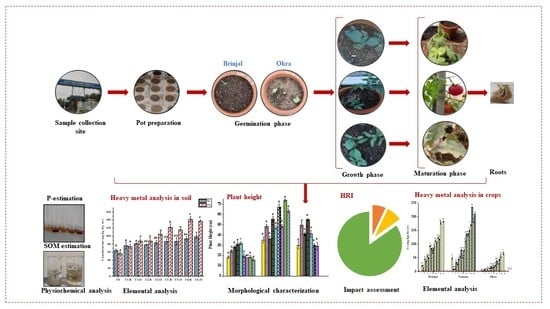Assessment of Heavy Metal Distribution and Health Risk of Vegetable Crops Grown on Soils Amended with Municipal Solid Waste Compost for Sustainable Urban Agriculture
Abstract
1. Introduction
2. Materials and Methods
2.1. Study Design, Experimental Layout, and Treatments
2.2. Physiochemical Analysis Soil and MSWC
2.3. Plant Health and Yield Assessment
2.4. Total Heavy Metal Analysis of Soil, Treatments, Compost, and Crops
2.5. Computation of Health Risk
2.5.1. Estimation of Heavy Metal Bioaccumulation Potential
2.5.2. Daily Heavy Metal Intake (DMI)
2.5.3. Health Risk Index (HRI)
2.6. Statistical Analysis
3. Results and Discussion
3.1. Physiochemical Properties of Soil Post Amendmending withMSWCs
| Treatment Groups | Control | MSWC-B | MSWC-O | Standard Values | ||||||||
|---|---|---|---|---|---|---|---|---|---|---|---|---|
| Parameters | T0 | T1-B | T2-B | T3-B | T4-B | T1-O | T2-O | T3-O | T4-O | SWM | OCQS | MIS |
| pH | 8.48 | 7.45 | 7.35 | 7.00 | 7.05 | 7.30 | 7.35 | 7.49 | 7.58 | 6.5–7.5 | 5.5–8.5 | 5–8 |
| EC (ds/m) | 0.10 | 0.28 | 1 | 3.00 | 4.61 | 0.23 | 1.30 | 2.30 | 5.52 | 4.0 | <4 | ≥6 |
| WHC (%) | 47 | 46 | 49 | 53 | 28 | 47 | 49 | 51 | 44 | - | ||
| Moisture Content (%) | 1.47 | 1.50 | 11.32 | 15.26 | 23.82 | 2.30 | 10.46 | 15.97 | 21.87 | 15–25 | 40–50 | 30–60 |
| Total N (%) | 0.14 | 1.12 | 1.35 | 1.40 | 1.40 | 0.90 | 1.23 | 1.39 | 1.12 | 0.80 | 0.5–6 | |
| OC (%) | 1.37 | 3.43 | 8.95 | 10 | 14.50 | 2.25 | 6.52 | 11.27 | 14.66 | 12.0 | ||
| SOM (%) | 2.36 | 7.00 | 20.00 | 25 | 31.90 | 5.00 | 23 | 41 | 53.27 | - | >30 | 40–60 |
| C:N ratio | 9.78 | 9.80 | 9.95 | 10 | 10.35 | 9.80 | 10.20 | 11.50 | 13.08 | <20 | <22 | |
| Available P (mg kg−1) | 7.10 | 10.31 | 120 | 264 | 271 | 14.25 | 135 | 256 | 265 | - | ||
| Available K (mg kg−1) | 175 | 146 | 147 | 154 | 157 | 143 | 146 | 135 | 143 | - | ||
| Available N (mg kg−1) | 47 | 39 | 36 | 36 | 37 | 34 | 36 | 35 | 34 | - | ||
3.2. Morphological Response of Crops to Treatments
3.2.1. S. melongena
3.2.2. S. lycopersicum
3.2.3. A. esculentus
3.3. Biomass and Yield
3.4. Available Heavy Metal Content in the Soil after Amendmending with MSWCs
| Cd | Cr | Cu | Ni | Pb | MSWC Concentration | |
|---|---|---|---|---|---|---|
| Cd | 1 | |||||
| Cr | 0.900 ** | 1 | ||||
| Cu | 0.837 ** | 0.874 ** | 1 | |||
| Ni | 0.535 ** | 0.637 ** | 0.433 * | 1 | ||
| Pb | 0.908 ** | 0.925 ** | 0.866 ** | 0.537 ** | 1 | |
| MSWC concentration | 0.950 ** | 0.963 ** | 0.894 ** | 0.639 ** | 0.964 ** | 1 |
| HMs | Soil/MSWC | Permissible Limit | |||||
|---|---|---|---|---|---|---|---|
| Soil | MSWC-B | MSWC-O | PFA a | USEPA b | FCO c | NEERI d | |
| Cu | 89.12 ± 6.39 | 398 ± 6.02 | 408.34 ± 6.39 | 137–270 | 56.5 | 300 | 326 ± 42.3 |
| Ni | 81 ± 3.68 | 93.2 ± 5.89 | 98.64 ± 5.61 | 75–150 | 72 | 50 | NA |
| Pb | 57 ± 3.60 | 142 ± 6.78 | 137.3 ± 2.9 | 250–500 | 200 | 100 | NA |
| Cr | 35.3 ± 6.88 | 165.6 ± 3.48 | 175.2 ± 5.52 | NA | NA | 50 | 40 ± 151.6 |
| Cd | 0.862 ± 0.01 | 7 ± 1.98 | 7.26 ± 2.36 | 3–6 | 0.48 | 5 | 2.66–4.86 |
| Hg | BDL | BDL | BDL | NA | NA | NA | NA |
| Heavy Metals in MSWC | Exceedance When Compared to Organic Soil (%) | Exceedance When Compared to FCO Standards (%) | ||
|---|---|---|---|---|
| MSWC-B | MSWC-O | MSWC-B | MSWC-O | |
| Cd | 712 | 742 | 40 | 45.2 |
| Cr | 369 | 396 | 231.2 | 250.4 |
| Ni | 45.65 | 54.125 | 86.4 | 97.28 |
| Pb | 149 | 141 | 42 | 37.3 |
| Cu | 346.58 | 358.19 | 32.66 | 36.11 |
| Hg | BDL | BDL | BDL | BDL |
3.5. Available Heavy Metal Content of Crops Grown in the Treatments
3.6. Human Health Risks Associated with Consumption of HMs Contaminated Crops
4. Conclusions
Supplementary Materials
Author Contributions
Funding
Institutional Review Board Statement
Informed Consent Statement
Data Availability Statement
Acknowledgments
Conflicts of Interest
References
- Appolloni, E.; Orsini, F.; Specht, K.; Thomaier, S.; Sanyé-Mengual, E.; Pennisi, G.; Gianquinto, G. The global rise of urban rooftop agriculture: A review of worldwide cases. J. Clean. Prod. 2021, 296, 126556. [Google Scholar] [CrossRef]
- Safayet, M.; Arefin, F.; Hasan, M.U. Present practice and future prospect of rooftop farming in Dhaka city: A step towards urban sustainability. J. Urban Manag. 2017, 6, 56–65. [Google Scholar] [CrossRef]
- Kabil, E.; Faize, M.; Makroum, K.; Assobhei, O.; Rafrafi, M.; Loizidou, M.; Aajjane, A. Effect of compost made with sludge and organic residues on soil and sugar beet crop in Morocco. J. Agron. 2015, 14, 264–271. [Google Scholar] [CrossRef][Green Version]
- Jamroz, E.; Bekier, J.; Medynska-Juraszek, A.; Kaluza-Haladyn, A.; Cwielag-Piasecka, I.; Bednik, M. The contribution of water extractable forms of plant nutrients to evaluate MSW compost maturity: A case study. Sci. Rep. 2020, 10, 12842. [Google Scholar] [CrossRef] [PubMed]
- Goulart, R.Z.; Reichert, J.M.; Rodrigues, M.F. Cropping poorly-drained lowland soils: Alternatives to rice monoculture, their challenges and management strategies. Agric. Syst. 2020, 177, 102715. [Google Scholar] [CrossRef]
- Riaz, A.; Younis, A.; Ghani, I.; Tariq, U.; Ahsan, M. Agricultural waste as growing media component for the growth and flowering of Gerbera jamesonii cv. hybrid mix. Int. J. Recycl. Org. Waste Agric. 2015, 4, 197–204. [Google Scholar] [CrossRef]
- Kumar, A.; Vandana; Singh, R.; Singh, M.; Pandey, K.D. Plant Growth Promoting Rhizobacteria (PGPR). A Promising Approach for Disease Management. In Microbes and Environmental Management; Studium Press: New Delhi, India, 2016; pp. 195–209. [Google Scholar]
- Ouatmane, M.; Provenzano, R.; Hafidi, M.; Senesi, N. Compost maturity assessment using calorimetry, spectroscopy and chemical analysis. Compost Sci. Util. 2000, 8, 124–134. [Google Scholar] [CrossRef]
- Srivastava, M.; Kumar, M. Impact of Solid Municipal Waste Landfills on Groundwater Resources: Need for Integrated Solid Waste Management Aligned with the Conservation of Groundwater. In Resilience, Response, and Risk in Water Systems; Springer Transactions in Civil and Environmental Engineering, Springer: Singapore, 2020; pp. 303–319. [Google Scholar] [CrossRef]
- Pandey, J.; Sarkar, S.; Pandey, V.C. Compost-assisted phytoremediation. In Assisted Phytoremediation; Elsevier: Amsterdam, The Netherlands, 2022; pp. 243–264. [Google Scholar] [CrossRef]
- Oueriemmi, H.; Kidd, P.; Trasar-Cepeda, C.; Rodríguez-Garrido, B.; Zoghlami, R.; Ardhaoui, K.; Prieto-Fernández, Á.; Moussa, M. Evaluation of Composted Organic Wastes and Farmyard Manure for Improving Fertility of Poor Sandy Soils in Arid Regions. Agriculture 2021, 11, 415. [Google Scholar] [CrossRef]
- Hargreaves, J.C.; Adl, M.S.; Warman, P.R. A review of the use of composted municipal solid waste in agriculture. Agric. Ecosyst. Environ. 2008, 123, 1–14. [Google Scholar] [CrossRef]
- Auffret, M.D.; Karhu, K.; Khachane, A.; Dungait, J.A.J.; Fraser, F.; Hopkins, D.W.; Wookey, P.A.; Singh, B.K.; Freitag, T.E.; Hartley, I.P.; et al. The Role of Microbial Community Composition in Controlling Soil Respiration Responses to Temperature. PLoS ONE 2016, 11, e0165448. [Google Scholar] [CrossRef]
- Margesin, R.; Cimadom, J.; Schinner, F. Biological activity during composting of sewage sludge at low temperatures. Int. Biodeterior. Biodegrad. 2006, 57, 88–92. [Google Scholar] [CrossRef]
- Heidari, G.; Mohammadi, K.; Sohrabi, Y. Responses of Soil Microbial Biomass and Enzyme Activities to Tillage and Fertilization Systems in Soybean (Glycine max L.) Production. Front. Plant Sci. 2016, 7, 1730. [Google Scholar] [CrossRef]
- Bouzaiane, O.; Jedidi, N.; Hassen, A. Microbial Biomass Improvement Following Municipal Solid Waste Compost Application in Agricultural Soil. In Composting for Sustainable Agriculture; Sustainable Development and Biodiversity; Springer: Cham, Switzerland, 2014; Volume 3. [Google Scholar] [CrossRef]
- Sotamenou, J.; Parrot, L. The determinants of organic fertilizers use in urban and peri-urban agriculture: An econometric analysis. Acta Hortic. 2014, 1021, 325–338. [Google Scholar] [CrossRef]
- Su, C.; Wang, J.; Chen, Z.; Meng, J.; Yin, G.; Zhou, Y.; Wang, T. Sources and health risks of heavy metals in soils and vegetables from intensive human intervention areas in South China. Sci. Total Environ. 2023, 857, 159389. [Google Scholar] [CrossRef]
- Shakil, S.; Nawaz, K.; Sadef, Y. Evaluation and environmental risk assessment of heavy metals in the soil released from e-waste management activities in Lahore, Pakistan. Environ. Monit. Assess. 2023, 195, 89. [Google Scholar] [CrossRef]
- Rinklebe, J.; Antoniadis, V.; Shaheen, S.M.; Rosche, O.; Altermann, M. Health risk assessment of potentially toxic elements in soils along the Central Elbe River, Germany. Environ. Int. 2019, 126, 76–88. [Google Scholar] [CrossRef]
- Safiur Rahman, M.; Khan, M.D.H.; Jolly, Y.N.; Kabir, J.; Akter, S.; Salam, A. Assessing risk to human health for heavy metal contamination through street dust in the Southeast Asian Megacity: Dhaka, Bangladesh. Sci. Total Environ. 2019, 660, 1610–1622. [Google Scholar] [CrossRef]
- Gan, L.; Wang, J.; Xie, M.; Yang, B. Ecological risk and health risk analysis of soil potentially toxic elements from oil production plants in central China. Sci. Rep. 2022, 12, 17077. [Google Scholar] [CrossRef]
- Bortone, I.; Chianese, S.; Erto, A.; Di Nardo, A.; Di Natale, M.; Santonastaso, G.F.; Musmarra, D. Risk analysis for a contaminated site in north of Naples (Italy). Chem. Eng. Trans. 2015, 43, 1927–1932. [Google Scholar] [CrossRef]
- Hartati, S.; Dono, D.; Meliansyah, R.; Yusuf, M.A. Effect of Neem Oil Formulation on the Population of Soil Fungi and Disease Intencity of Cercospora Leaf Spot (Cercospora capsici) on Chilli Plants (Capsicum annuum). J. Cropsaver 2018, 1, 53–60. [Google Scholar] [CrossRef]
- Walkley, J.; Black, I.A. Estimation of soil organic carbon by the chromic acid titration method. Soil Sci. 1934, 37, 29–38. [Google Scholar] [CrossRef]
- Subbiah, V.; Asija, G.L. A Rapid Procedure for the Estimation of Available Nitrogen in Soils. Curr. Sci. 1956, 25, 259–260. [Google Scholar]
- Bray, R.H.; Kurtz, L.T. Determination of total, organic, and available forms of phosphorus in soils. Soil Sci. 1945, 59, 39–46. [Google Scholar] [CrossRef]
- Hanway, J.; Heidel, H. Soil analyses methods as used in Iowa state college soil testing laboratory. Iowa Agric. 1952, 57, 1–31. [Google Scholar]
- Behera, S.K.; Shukla, A.K. Spatial Distribution of Surface Soil Acidity, Electrical Conductivity, Soil Organic Carbon Content and Exchangeable Potassium, Calcium and Magnesium in Some Cropped Acid Soils of India. Land Degrad. Dev. 2015, 26, 71–79. [Google Scholar] [CrossRef]
- Sastre, J.; Sahuquillo, A.; Vidal, M.; Rauret, G. Determination of Cd, Cu, Pb and Zn in environmental samples: Microwave-assisted total digestion versus aqua regia and nitric acid extraction. Anal. Chim. Acta 2002, 462, 59–72. [Google Scholar] [CrossRef]
- Gaudino, S.; Galas, C.; Belli, M.; Barbizzi, S.; de Zorzi, P.; Jaćimović, R.; Jeran, Z.; Pati, A.; Sansone, U. The role of different soil sample digestion methods on trace elements analysis: A comparison of ICP-MS and INAA measurement results. Accredit. Qual. Assur. 2007, 12, 84–93. [Google Scholar] [CrossRef]
- Mukherjee, P.; Mitra, A.; Roy, M. Halomonas rhizobacteria of Avicennia marina of Indian sundarbans promote rice growth under saline and heavy metal stresses through exopolysaccharide production. Front. Microbiol. 2019, 10, 1207. [Google Scholar] [CrossRef]
- Hawrami, K.A.M.; Crout, N.M.J.; Shaw, G.; Bailey, E.H. Assessment of potentially toxic elements in vegetables cultivated in urban and peri-urban sites in the Kurdistan region of Iraq and implications for human health. Environ. Geochem. Health 2020, 42, 1359–1385. [Google Scholar] [CrossRef]
- USEPA IRIS (US Environmental Protection Agency)’s Integrated Risk Information System; Environmental Protection Agency Region I: Washington, DC, USA. 2011. Available online: http://www.epa.gov/iris/ (accessed on 7 December 2022).
- Latif, A.; Bilal, M.; Asghar, W.; Azeem, M.; Ahmad, M.Z.; Abbas, A.; Shahzad, T. Heavy Metal Accumulation in Vegetables and Assessment of their Potential Health Risk. J. Environ. Anal. Chem. 2018, 5, 1. [Google Scholar] [CrossRef]
- Yang, T.; Siddique, K.H.M.; Liu, K. Cropping systems in agriculture and their impact on soil health-A review. Glob. Ecol. Conserv. 2020, 23, e01118. [Google Scholar] [CrossRef]
- Ozlu, E.; Kumar, S. Response of Soil Organic Carbon, pH, Electrical Conductivity, and Water Stable Aggregates to Long-Term Annual Manure and Inorganic Fertilizer. Soil Sci. Soc. Am. J. 2018, 82, 1243–1251. [Google Scholar] [CrossRef]
- Meena, M.D.; Yadav, R.K.; Narjary, B.; Yadav, G.; Jat, H.S.; Sheoran, P.; Meena, M.K.; Antil, R.S.; Meena, B.L.; Singh, H.V.; et al. Municipal solid waste (MSW): Strategies to improve salt affected soil sustainability: A review. Waste Manag. 2019, 84, 38–53. [Google Scholar] [CrossRef]
- Williams, A.; Hunter, M.C.; Kammerer, M.; Kane, D.A.; Jordan, N.R.; Mortensen, D.A.; Smith, R.G.; Snapp, S.; Davis, A.S. Soil Water Holding Capacity Mitigates Downside Risk and Volatility in US Rainfed Maize: Time to Invest in Soil Organic Matter? PLoS ONE 2016, 11, e0160974. [Google Scholar] [CrossRef]
- Belén Almendro-Candel, M.; Navarro-Pedreño, J.; Gómez Lucas, I.; Zorpas, A.A.; Voukkali, I.; Loizia, P. The Use of Composted Municipal Solid Waste under the Concept of Circular Economy and as a Source of Plant Nutrients and Pollutants. In Municipal Solid Waste Management; IntechOpen: London, UK, 2019. [Google Scholar] [CrossRef]
- Carbonell, G.; de Imperial, R.M.; Torrijos, M.; Delgado, M.; Rodriguez, J.A. Effects of municipal solid waste compost and mineral fertilizer amendments on soil properties and heavy metals distribution in maize plants (Zea mays L.). Chemosphere 2011, 85, 1614–1623. [Google Scholar] [CrossRef]
- Ding, X.; Han, X.; Liang, Y.; Qiao, Y.; Li, L.; Li, N. Changes in soil organic carbon pools after 10 years of continuous manuring combined with chemical fertilizer in a Mollisol in China. Soil Tillage Res. 2012, 122, 36–41. [Google Scholar] [CrossRef]
- Abolfazli, F.; Forghani, A.; Norouzi, M. Effects of phosphorus and organic fertilizers on phosphorus fractions in submerged soil. J. Soil Sci. Plant Nutr. 2012, 12, 349–362. [Google Scholar] [CrossRef]
- Turrión, M.-B.; Bueis, T.; Lafuente, F.; López, O.; José, E.S.; Eleftheriadis, A.; Mulas, R. Effects on soil phosphorus dynamics of municipal solid waste compost addition to a burnt and unburnt forest soil. Sci. Total Environ. 2018, 642, 374–382. [Google Scholar] [CrossRef]
- Angin, E.; Aksakal, L.; Oztas, T.; Hanay, A. Effects of municipal solid waste compost (MSWC) application on certain physical properties of soils subjected to freeze–thaw. Soil Tillage Res. 2013, 130, 58–61. [Google Scholar] [CrossRef]
- Rupasinghe, S.U.; Leelamanie, D.A.L. Comparison of municipal and agriculture-based solid waste composts: Short-term crop-yield response and soil properties in a tropical Ultisol. Biologia 2020, 75, 809–818. [Google Scholar] [CrossRef]
- Arrobas, M.; Thais Nepomuceno Carvalho, J.; Raimundo, S.; Poggere, G.; Rodrigues, M.Â. The safe use of compost derived from municipal solid waste depends on its composition and conditions of application. Soil Use Manag. 2022, 38, 917–928. [Google Scholar] [CrossRef]
- Zaccardelli, M.; Pane, C.; di Mola, I.; Ronga, D.; Mori, M. Municipal organic waste compost replaces mineral fertilization in the horticultural cropping systems, reducing the pollution risk. Ital. J. Agron. 2021, 16, 1756. [Google Scholar] [CrossRef]
- Solid Waste Management Rules, 2016. Central Pollution Control Board, Ministry of Environment, Forest and Climate Change. Government of India. Available online: https://cpcb.nic.in/rules-2/ (accessed on 16 December 2022).
- Ontario Compost Quality Standards by Ontario Ministry of the Environment, Waste Management Policy Branch, July 2012. Available online: https://www.ontario.ca/page/ontario-compost-quality-standards (accessed on 16 December 2022).
- Ozores-Hampton, M. Guidelines for Assessing Compost Quality for Safe and Effective Utilization in Vegetable Production. Horttechnology 2017, 27, 162–165. [Google Scholar] [CrossRef]
- Horrocks, A.; Curtin, D.; Tregurtha, C.; Meenken, E. Municipal Compost as a Nutrient Source for Organic Crop Production in New Zealand. Agronomy 2016, 6, 35. [Google Scholar] [CrossRef]
- Razavi Nasab, A.; Fotovat, A.; Astaraie, A.; Tajabadipour, A. Effect of Organic Waste and Humic Acid on Some Growth Parameters and Nutrient Concentration of Pistachio Seedlings. Commun. Soil Sci. Plant Anal. 2019, 50, 254–264. [Google Scholar] [CrossRef]
- Srivastava, V.; Gupta, S.K.; Singh, P.; Sharma, B.; Singh, R.P. Biochemical, physiological, and yield responses of lady’s finger (Abelmoschus esculentus L.) grown on varying ratios of municipal solid waste vermicompost. Int. J. Recycl. Org. Waste Agric. 2018, 7, 241–250. [Google Scholar] [CrossRef]
- Chrysargyris, A.; Stamatakis, A.; Moustakas, K.; Prasad, M.; Tzortzakis, N. Evaluation of Municipal Solid Waste Compost and/or Fertigation as Peat Substituent for Pepper Seedlings Production. Waste Biomass Valoriz. 2018, 9, 2285–2294. [Google Scholar] [CrossRef]
- Ho, T.T.K.; Tra, V.T.; Le, T.H.; Nguyen, N.-K.; Tran, C.-S.; Nguyen, P.-T.; Vo, T.-D.; Thai, V.-N.; Bui, X.-T. Compost to improve sustainable soil cultivation and crop productivity. Case Stud. Chem. Environ. Eng. 2022, 6, 100211. [Google Scholar] [CrossRef]
- Moretti, B.; Bertora, C.; Grignani, C.; Lerda, C.; Celi, L.; Sacco, D. Conversion from mineral fertilisation to MSW compost use: Nitrogen fertiliser value in continuous maize and test on crop rotation. Sci. Total Environ. 2020, 705, 135308. [Google Scholar] [CrossRef]
- Salam, B.A.; Ashrafuzzaman, M.; Sikder, S.; Mahmud, A.; Joardar, J.C. Influence of municipal solid waste compost on yield of tomato-applied solely and in combination with inorganic fertilizer where nitrogen is the only variable factor. Malays. J. Sustain. Agric. 2020, 5, 29–33. [Google Scholar] [CrossRef]
- Frimpong, K.; Asare-Bediako, E.; Amissah, R.; Okae-Anti, D. Influence of Compost on Incidence and Severity of Okra Mosaic Disease and Fruit Yield and Quality of Two Okra (Abelmoschus esculentus L. Moench) Cultivars. Int. J. Plant Soil Sci. 2017, 16, 1–14. [Google Scholar] [CrossRef][Green Version]
- Rietra, R.P.J.J.; Heinen, M.; Dimkpa, C.O.; Bindraban, P.S. Effects of Nutrient Antagonism and Synergism on Yield and Fertilizer Use Efficiency. Commun. Soil Sci. Plant Anal. 2017, 48, 1895–1920. [Google Scholar] [CrossRef]
- Sarwar, N.; Imran, M.; Shaheen, M.R.; Ishaque, W.; Kamran, M.A.; Matloob, A.; Rehim, A.; Hussain, S. Phytoremediation strategies for soils contaminated with heavy metals: Modifications and future perspectives. Chemosphere 2017, 171, 710–721. [Google Scholar] [CrossRef]
- Abou Jaoude, L.; Garau, G.; Nassif, N.; Darwish, T.; Castaldi, P. Metal(loid)s immobilization in soils of Lebanon using municipal solid waste compost: Microbial and biochemical impact. Appl. Soil Ecol. 2019, 143, 134–143. [Google Scholar] [CrossRef]
- Domínguez, M.; Núñez, R.P.; Piñeiro, J.; Barral, M.T. Physicochemical and biochemical properties of an acid soil under potato culture amended with municipal solid waste compost. Int. J. Recycl. Org. Waste Agric. 2019, 8, 171–178. [Google Scholar] [CrossRef]
- Bhatnagar, J.P.; Awasthi, S.K. Prevention of Food Adulteration Act (Act No. 37 of 1954) Alongwith Central & State Rules (as Amended for 1999), 3rd ed.; Ashoka Law House: New Delhi, India, 2000. [Google Scholar]
- Mandal, P.; Chaturvedi, M.K.; Bassin, J.K.; Vaidya, A.N.; Gupta, R.K. Qualitative assessment of municipal solid waste compost by indexing method. Int. J. Recycl. Org. Waste Agric. 2014, 3, 133–139. [Google Scholar] [CrossRef]
- Giannakis, G.V.; Kourgialas, N.N.; Paranychianakis, N.V.; Nikolaidis, N.P.; Kalogerakis, N. Effects of municipal solid waste compost on soil properties and vegetables growth. Compost Sci. Util. 2014, 22, 116–131. [Google Scholar] [CrossRef]
- Yüksel, O. Influence of municipal solid waste compost application on heavy metal content in soil. Environ. Monit. Assess. 2015, 187, 313. [Google Scholar] [CrossRef]
- Paradelo, R.; Villada, A.; Devesa-Rey, R.; Moldes, A.B.; Domínguez, M.; Patiño, J.; Barral, M.T. Distribution and availability of trace elements in municipal solid waste composts. J. Environ. Monit. 2011, 13, 201–211. [Google Scholar] [CrossRef]
- Lopes, C.; Herva, M.; Franco-Uría, A.; Roca, E. Inventory of heavy metal content in organic waste applied as fertilizer in agriculture: Evaluating the risk of transfer into the food chain. Environ. Sci. Pollut. Res. 2011, 18, 918–939. [Google Scholar] [CrossRef]
- Alengebawy, S.; Abdelkhalek, T.; Qureshi, S.R.; Wang, M.-Q. Heavy Metals and Pesticides Toxicity in Agricultural Soil and Plants: Ecological Risks and Human Health Implications. Toxics 2021, 9, 42. [Google Scholar] [CrossRef] [PubMed]
- Noor, T.; Javid, A.; Hussain, A.; Bukhari, S.M.; Ali, W.; Akmal, M.; Hussain, S.M. Types, sources and management of urban wastes. In Urban Ecology; Elsevier: Amsterdam, The Netherlands, 2020; pp. 239–263. [Google Scholar] [CrossRef]
- Ashfaq, Z.; Khan, I.; Ahmad, K.; Ashraf, M.A.; Hussain, M.I.; Elghareeb, E.M. Hazard of selenium metal contamination in vegetables grown in municipal solid waste amended soil: Assessment of the potential sources and systemic health effects. Agric. Water Manag. 2022, 271, 107768. [Google Scholar] [CrossRef]
- Singh, A.; Chandel, M.K. Mobility and environmental fate of heavy metals in fine fraction of dumped legacy waste: Implications on reclamation and ecological risk. J. Environ. Manag. 2022, 304, 114206. [Google Scholar] [CrossRef] [PubMed]
- U.S. Environmental Protection Agency (USEPA). PRG Tables. Preliminary Remediation Goals. Solid and Hazardous Waste Programs; Region 9; U.S. Environment Protection Agency: Washington, DC, USA, 2002.
- Li, F.; Shi, W.; Jin, Z.; Wu, H.; Sheng, G.D. Excessive uptake of heavy metals by greenhouse vegetables. J. Geochem. Explor. 2017, 173, 76–84. [Google Scholar] [CrossRef]
- Paradelo, R.; Villada, A.; Barral, M.T. Heavy Metal Uptake of Lettuce and Ryegrass from Urban Waste Composts. Int. J. Environ. Res. Public Health. 2020, 17, 2887. [Google Scholar] [CrossRef] [PubMed]
- Escobedo-Monge, M.A.; Aparicio, S.; Escobedo-Monge, M.F.; Marugán-Miguelsanz, J.M. Long-term effects of the application of urban waste compost and other organic amendments on Solanum tuberosum L. Agronomy 2020, 10, 1575. [Google Scholar] [CrossRef]
- Tessfaw, Z.A.; Beyene, A.; Nebiyu, A.; Pikon, K.; Landrat, M. Heavy Metals Accumulations And Health Risk Assessment Of Faba Bean Grow On Soil Amended with Municipal Solid Waste Compost, Biochar And Co-Composted Biochar. Res. Sq. 2021. preprint. [Google Scholar] [CrossRef]
- Zhivotovsky, P.; Kuzovkina, Y.A.; Schulthess, C.P.; Morris, T.; Pettinelli, D. Lead uptake and translocation by willows in pot and field experiments. Int. J. Phytoremediat. 2011, 13, 731–749. [Google Scholar] [CrossRef]
- FAO/WHO. Food Standards Programme Codex Committee on Contaminants in Foods, Fifth Session; FAO: The Hague, The Netherlands, 2011. [Google Scholar]
- Satpathy, M.; Reddy, V.; Dhal, S.P. Risk assessment of heavy metals contamination in paddy soil, plants, and grains (Oryza sativa L.) at the east coast of India. BioMed Res. Int. 2014, 2014, 545473. [Google Scholar] [CrossRef]
- Dada, O.A.; Kutu, F.R. Bioavailability and health risk assessment of potentially toxic elements in popcorn kernel from sandy loam Ferric Luvisol amended with municipal solid waste compost. Environ. Geochem. Health 2022, 44, 2389–2405. [Google Scholar] [CrossRef]
- Sharma, N.; Sharma, R.K.; Samant, S.S.; Pande, V.; Kumar, U.; Singh, P.K. Land application of municipal compost in mountain ecosystem: Effects on growth, biomass and heavy metal uptake by vegetable crops. Int. J. Agric. Plant Sci. 2022, 4, 1–9. [Google Scholar]
- Shah, G.M.; Tufail, N.; Bakhat, H.F.; Ahmad, I.; Shahid, M.; Hammad, H.M.; Nasim, W.; Waqar, A.; Rizwan, M.; Dong, R. Composting of municipal solid waste by different methods improved the growth of vegetables and reduced the health risks of cadmium and lead. Environ. Sci. Pollut. Res. 2019, 26, 5463–5474. [Google Scholar] [CrossRef]


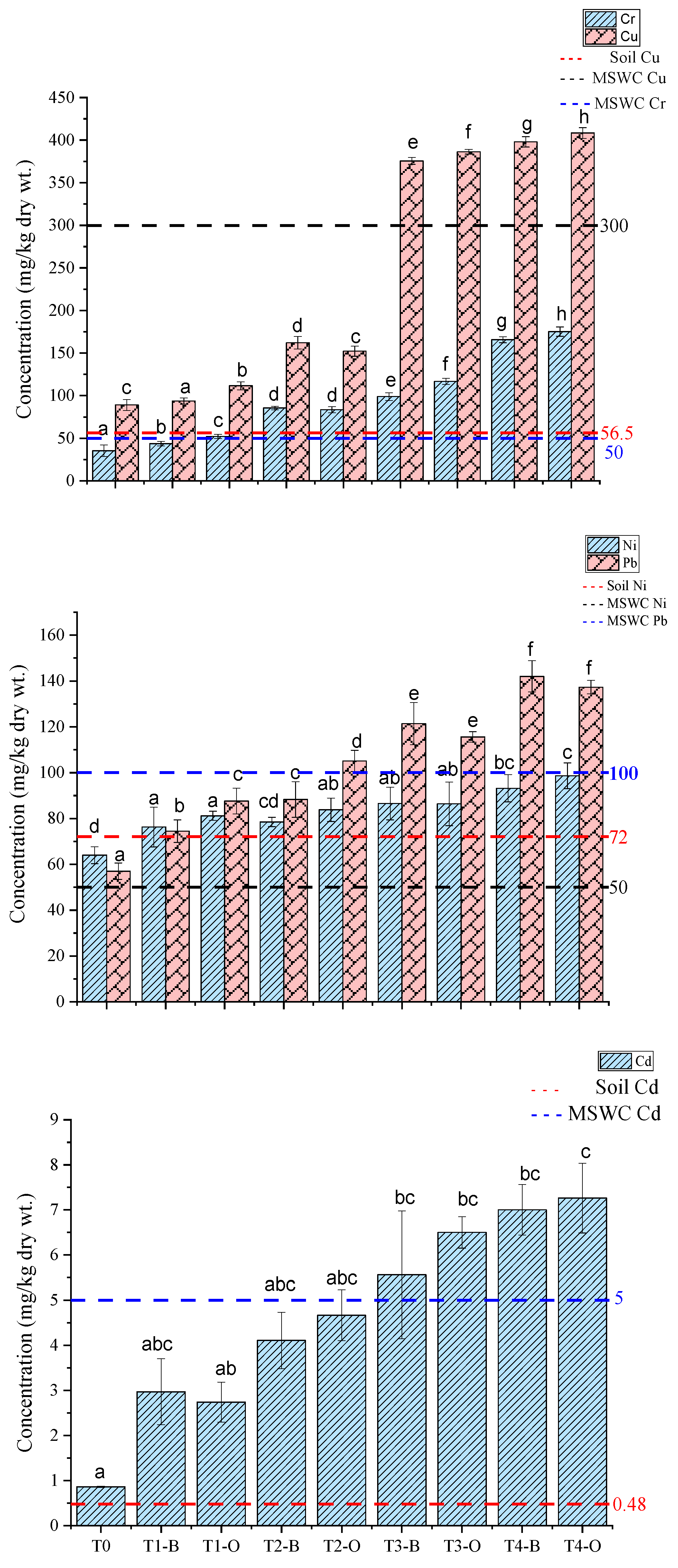


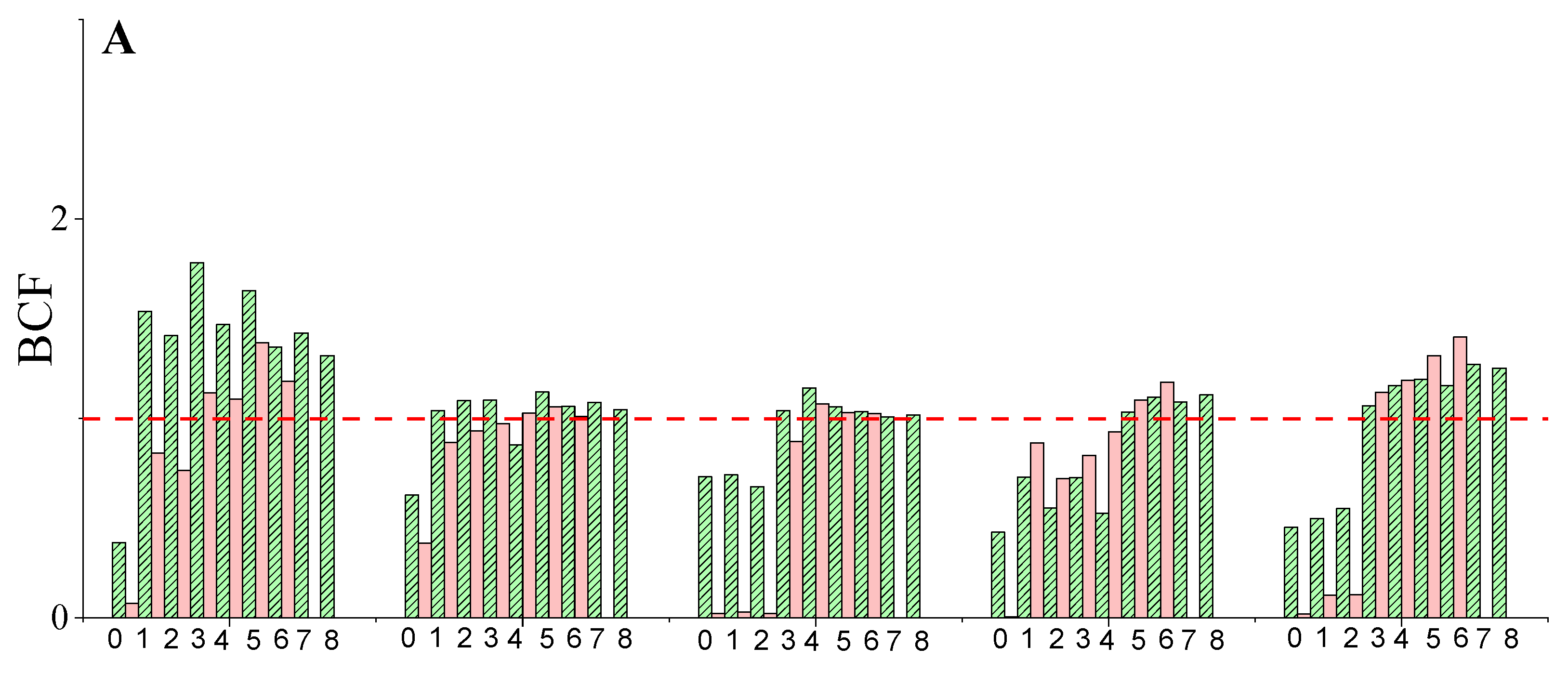
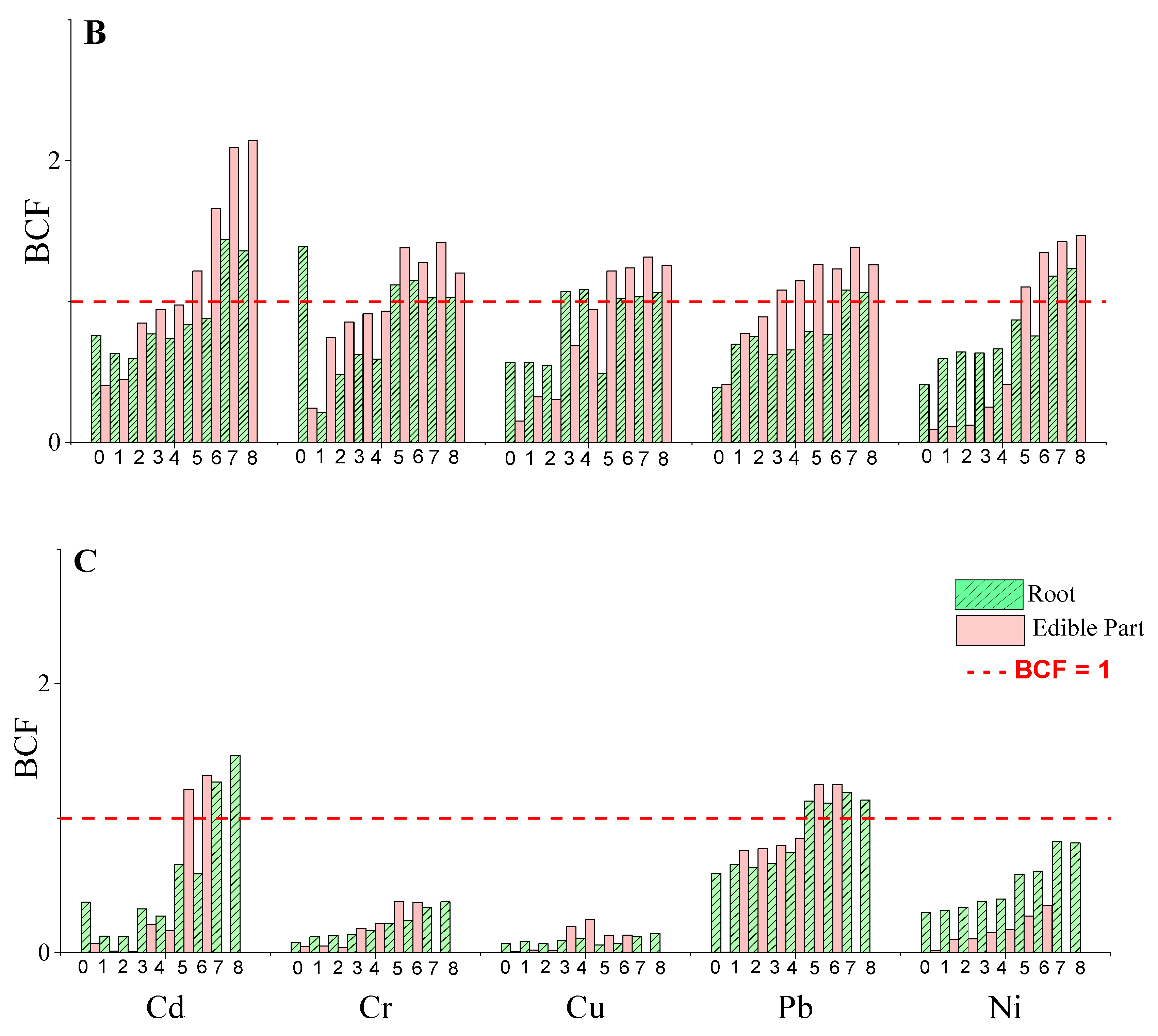
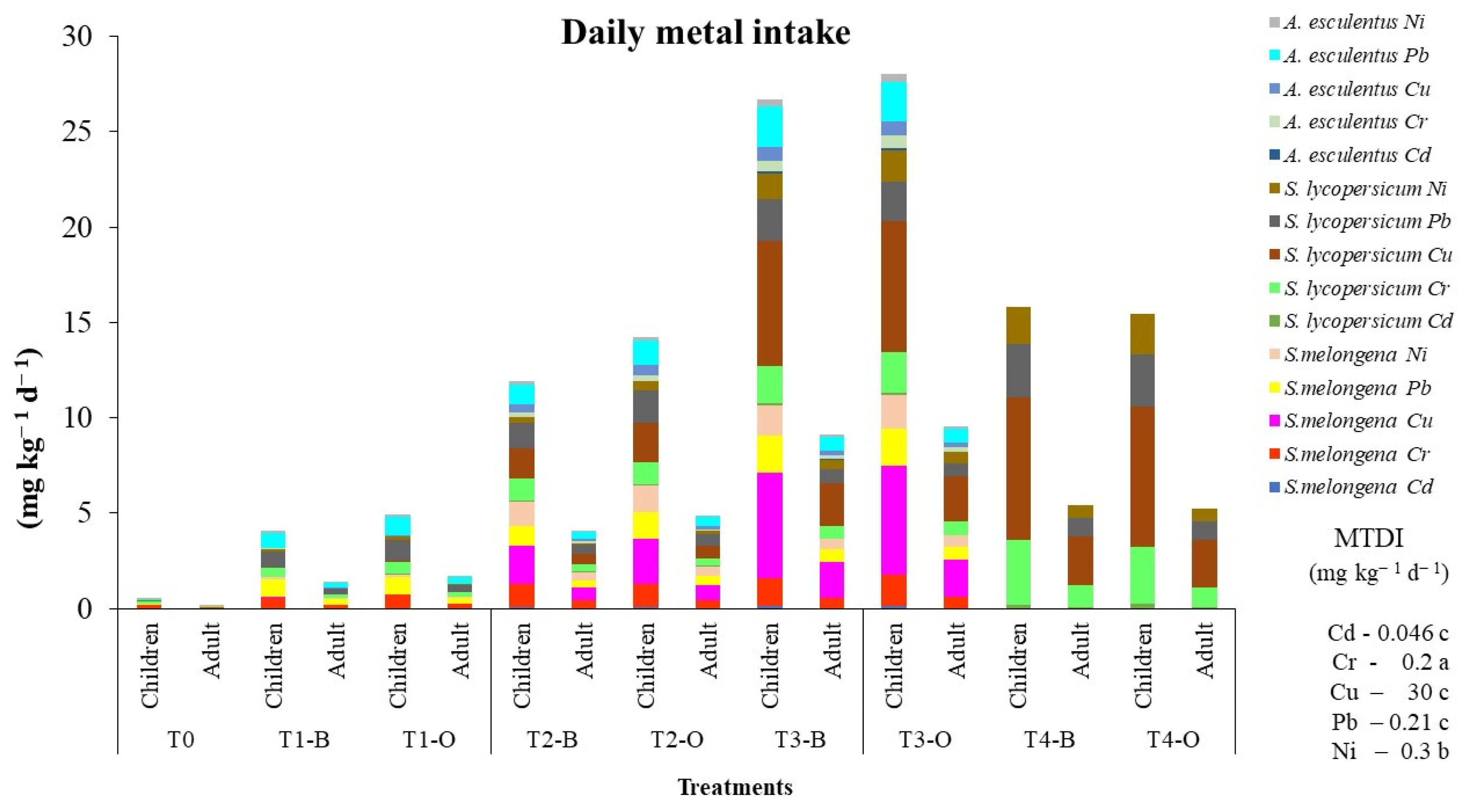
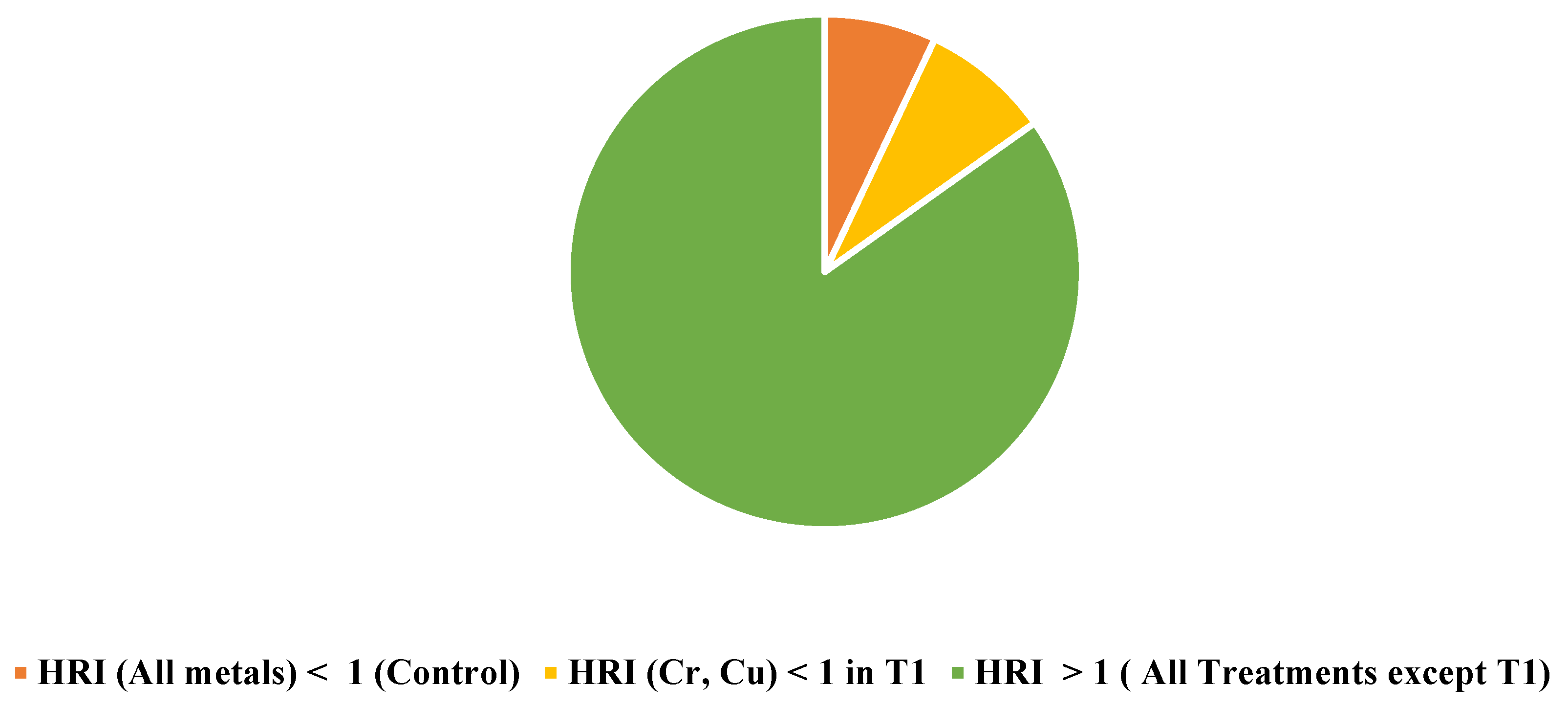
| MSWC (%) | |||||
|---|---|---|---|---|---|
| Treatments | Soil (%) | MSWC-B | MSWC-O | ||
| Treatment Groups | Control | T0 | 100 | 0 | 0 |
| MSWC-B | T1-B | 75 | 25 | 0 | |
| T2-B | 50 | 50 | 0 | ||
| T3-B | 25 | 75 | 0 | ||
| T4-B | 0 | 100 | 0 | ||
| MSWC-O | T1-O | 75 | 0 | 25 | |
| T2-O | 50 | 0 | 50 | ||
| T3-O | 25 | 0 | 75 | ||
| T4-O | 0 | 0 | 100 | ||
Disclaimer/Publisher’s Note: The statements, opinions and data contained in all publications are solely those of the individual author(s) and contributor(s) and not of MDPI and/or the editor(s). MDPI and/or the editor(s) disclaim responsibility for any injury to people or property resulting from any ideas, methods, instructions or products referred to in the content. |
© 2023 by the authors. Licensee MDPI, Basel, Switzerland. This article is an open access article distributed under the terms and conditions of the Creative Commons Attribution (CC BY) license (https://creativecommons.org/licenses/by/4.0/).
Share and Cite
Bhardwaj, P.; Sharma, R.K.; Chauhan, A.; Ranjan, A.; Rajput, V.D.; Minkina, T.; Mandzhieva, S.S.; Mina, U.; Wadhwa, S.; Bobde, P.; et al. Assessment of Heavy Metal Distribution and Health Risk of Vegetable Crops Grown on Soils Amended with Municipal Solid Waste Compost for Sustainable Urban Agriculture. Water 2023, 15, 228. https://doi.org/10.3390/w15020228
Bhardwaj P, Sharma RK, Chauhan A, Ranjan A, Rajput VD, Minkina T, Mandzhieva SS, Mina U, Wadhwa S, Bobde P, et al. Assessment of Heavy Metal Distribution and Health Risk of Vegetable Crops Grown on Soils Amended with Municipal Solid Waste Compost for Sustainable Urban Agriculture. Water. 2023; 15(2):228. https://doi.org/10.3390/w15020228
Chicago/Turabian StyleBhardwaj, Pallavi, Rajesh Kumar Sharma, Abhishek Chauhan, Anuj Ranjan, Vishnu D. Rajput, Tatiana Minkina, Saglara S. Mandzhieva, Usha Mina, Shikha Wadhwa, Prakash Bobde, and et al. 2023. "Assessment of Heavy Metal Distribution and Health Risk of Vegetable Crops Grown on Soils Amended with Municipal Solid Waste Compost for Sustainable Urban Agriculture" Water 15, no. 2: 228. https://doi.org/10.3390/w15020228
APA StyleBhardwaj, P., Sharma, R. K., Chauhan, A., Ranjan, A., Rajput, V. D., Minkina, T., Mandzhieva, S. S., Mina, U., Wadhwa, S., Bobde, P., & Tripathi, A. (2023). Assessment of Heavy Metal Distribution and Health Risk of Vegetable Crops Grown on Soils Amended with Municipal Solid Waste Compost for Sustainable Urban Agriculture. Water, 15(2), 228. https://doi.org/10.3390/w15020228











